Managing emails can feel overwhelming, but with Gmelius, it doesn't have to be. Our email management software is designed to simplify your workload and empower your team to collaborate directly within Gmail.
What Is Email Management? It’s Communication 101
While staying on top of emails is crucial for communicating with clients and colleagues, it often eats up a significant portion of your workday, pulling your focus away from essential tasks.
An email management solution can help you tackle common inbox issues, enabling your team to collaborate more effectively on incoming tasks. But you might be wondering: "What exactly is email management?" and "How can I actually implement this for my business?"
Email management definition
Email management is the art of organizing, capturing, and responding to the massive flow of emails an organization receives.
Many companies are swamped with internal emails, like support teams handling customer requests via support@ or operations teams managing orders sent to their orders@ mailbox and as a result, email management issues are extremely common.

An email management solution can be a lifesaver, helping your team overcome communication hurdles across departments.
Business Problems that Email Management Solves
Email management helps address:
1. Inbox clutter
For many, email management simply means sorting and clearing out their inbox. But doing this manually is like trying to empty the ocean with a teacup: it just won't produce efficient, long-term results.
The average person’s inbox holds around 200 unread emails, which might seem manageable. However, considering the average worker receives 121 emails per day, that number can quickly balloon to over 600 emails needing a response by week's end if not properly managed.

A cluttered inbox can have serious negative consequences for your company. Important inquiries can get lost in the shuffle, and valuable conversations can go missing. For remote or hybrid teams, email is often where crucial discussions happen, containing vital information that team members and management need to address.
When these conversations disappear, there’s no record to refer back to. This is why email management is essential for controlling inbox clutter and improving processes for remote teams.
2. Endless CC lists
Keeping everyone in the loop is important, but those long email threads can be a nightmare to track. Plus, a lot of time is wasted just making sure the right people are included in every task, which really cuts into productivity.
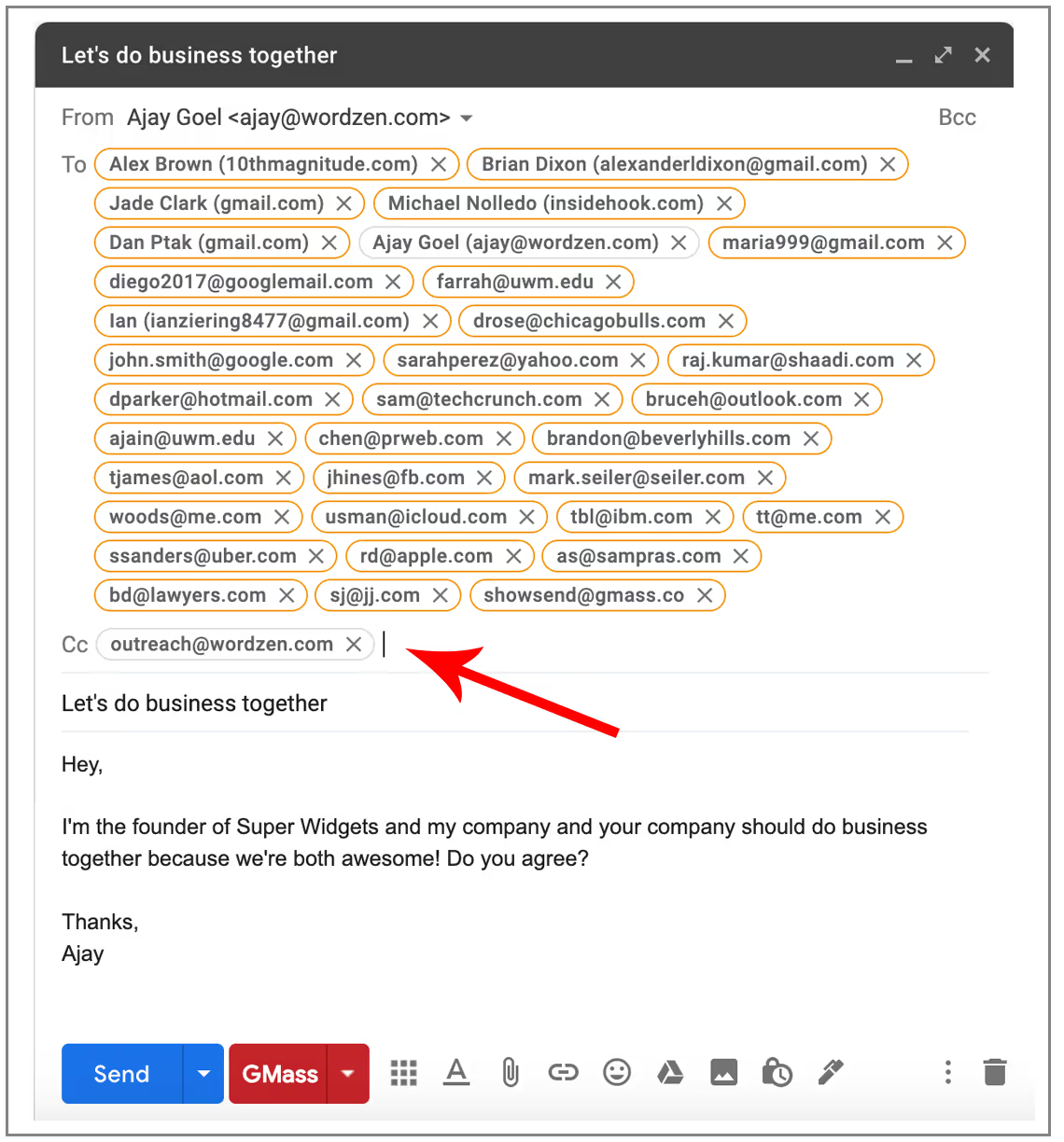
3. Incomplete records
Maintaining a clear record of company emails ensures that important inquiries are well-documented and safely stored. Since most company interactions happen via email, these conversations are vital records for your business. If these emails go missing, it could be truly detrimental.
4. Delegating and assigning tasks
Assigning projects and delegating tasks can eat up a significant chunk of your day. And if your team is remote, simply walking over to a colleague's desk isn't an option. Every exchange happens through various communication platforms, and for discussions that don't need an immediate reply, email is the top choice.
However, bouncing between multiple email accounts and juggling numerous tasks can lead to increased response times as you wait for the right team member to reply. Instead, following email management tips can lead to better project workflows.
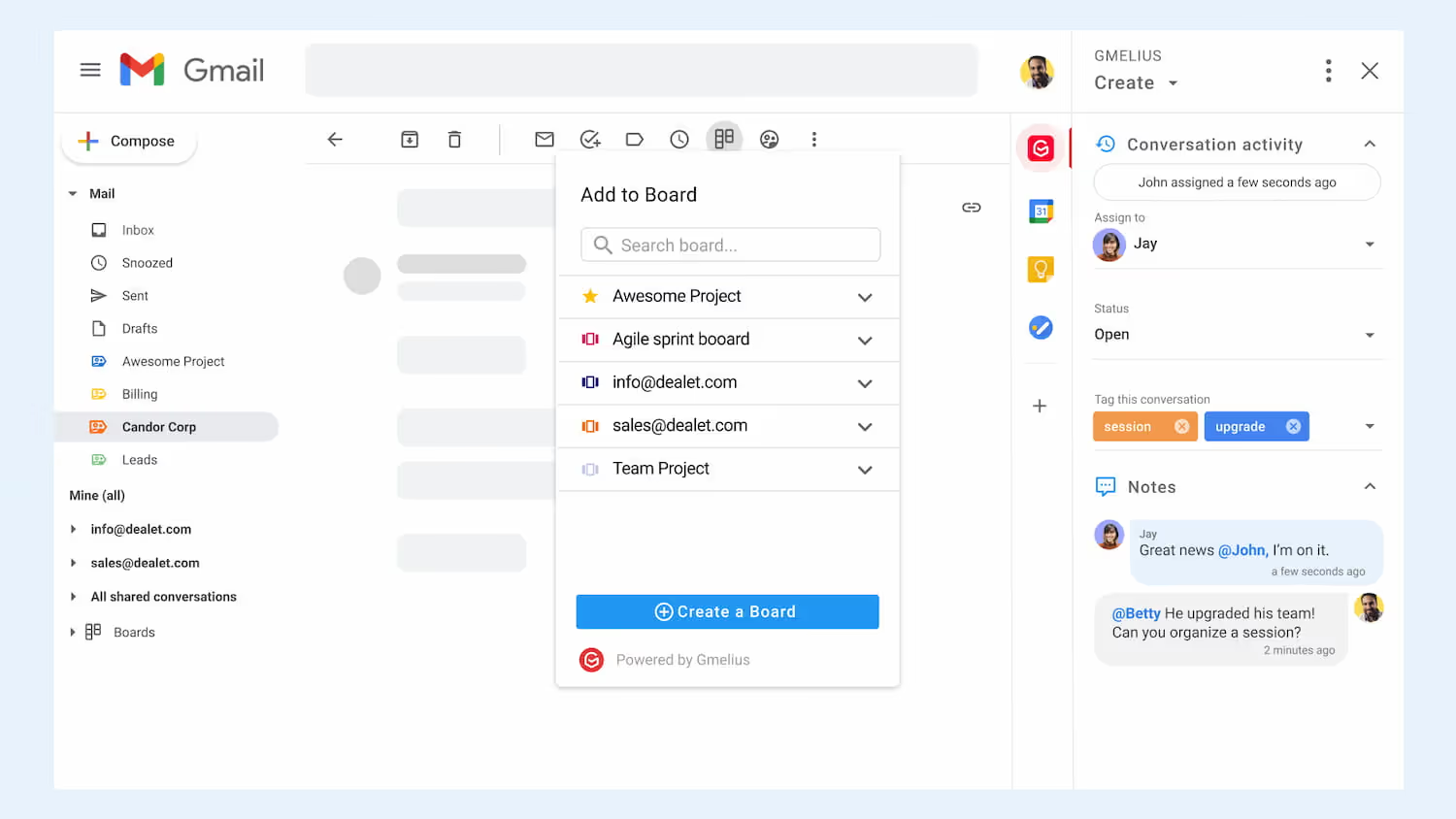
So quickly, let’s take you through our 10 recommendations for smarter email management.
10 Proven Email Management Techniques
When your inbox is running you instead of the other way around, productivity takes a hit. A few intentional habits (combined with the right tools) can help you reclaim your time and focus.
Here’s how to get your email workflow under control and keep it that way:
1. Apply the 2-minute rule
From David Allen’s Getting Things Done: if a task takes less than two minutes, do it immediately. Read the email, take the action (reply, delete, forward) and move on without lingering.
2. Create filters that match your workflow
Your inbox won’t prioritize on its own. Set up filters that automatically sort or archive messages based on sender, keywords, or labels, reducing noise without losing context.
3. Archive aggressively, search when needed
A cluttered inbox is mental clutter. Move non-essential messages out of sight, and use Gmail’s powerful search to retrieve them when necessary.
4. Set dedicated response windows
Email doesn’t need to interrupt every 10 minutes. Block specific times in your day for processing messages. It trains others to respect your focus, and helps you protect it.
5. Opt for labels over folders
Gmail labels allow a single email to live in multiple categories, giving you a more flexible and adaptive organization system than rigid folders.
#ProTip: Share email labels with team members to manage your inbox together.

6. Save and share email templates
Stop retyping common responses. Activate Gmail templates (Settings → Advanced → Enable Templates) and share them with your team for speed and consistency.
#ProTip: Embed images in Gmail templates to solve frequent queries more effectively.
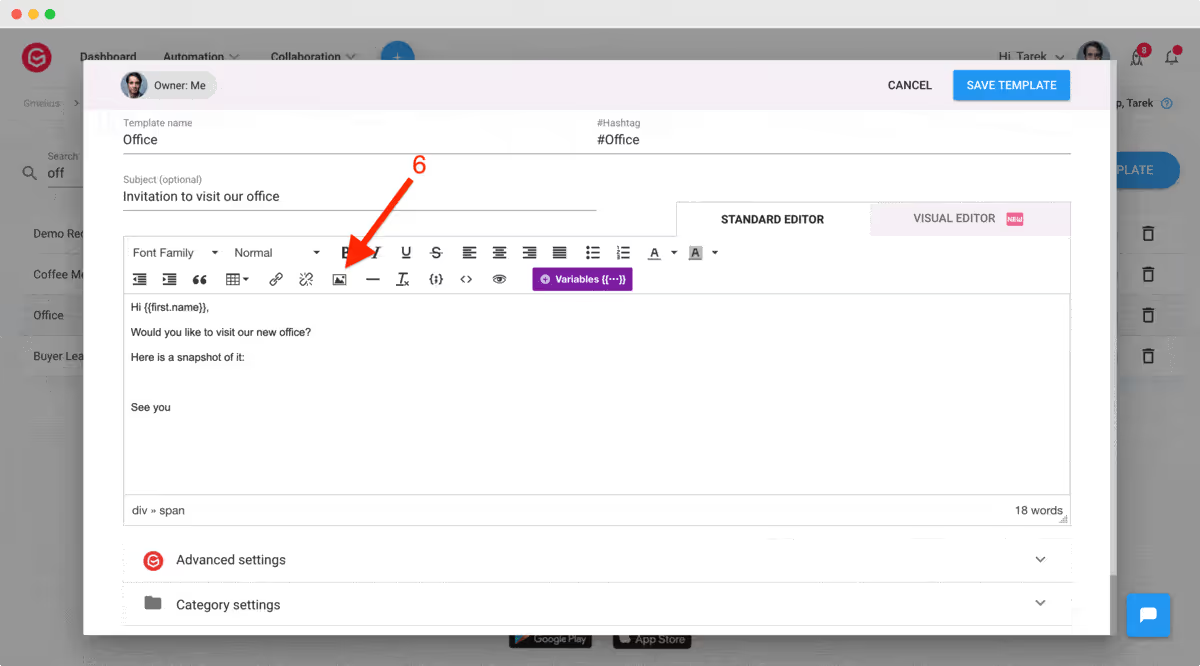
7. Turn emails into tasks
Don’t rely on memory for follow-ups. Convert actionable emails into tasks in your project management tool or Gmail’s task list to avoid dropped responsibilities.
8. Delegate without the chain of forwards
Instead of lengthy forwarding loops, use collaboration features (like Gmelius shared inboxes) to assign, comment, and track emails directly in Gmail.
9. Aim for inbox intentional, not inbox zero
Inbox Zero is a nice milestone but not always realistic. The real goal is an inbox you trust — reviewed daily for a specific time and processed with intention.
10. Leverage AI assistants for automation
AI tools now handle sorting, drafting, and prioritizing, letting you focus on decisions rather than triage.
By adopting these email management techniques and integrating them into a consistent system, you can transform email from a daily source of stress into a streamlined, manageable part of your workflow.
How an Email Management Solution Benefits Your Team
With asynchronous communication becoming the norm for remote and hybrid work – and even for Gen Z email management software can help your team organize tasks, delegate assignments, and automate workflows all within one email platform.
So, let’s run down the most obvious and enduring benefits of an email management solution:
1. Saves time through clear workflows
With shared inbox tools like Gmelius, teams can instantly see who’s responsible for each message. No more digging through threads or asking, “Has anyone replied to this?”as the status is visible at a glance, eliminating delays.
2. Improves productivity by reducing context switching
When emails can be turned into tasks and tracked on Kanban boards directly inside Gmail, team members spend less time moving between apps and more time completing work that matters.
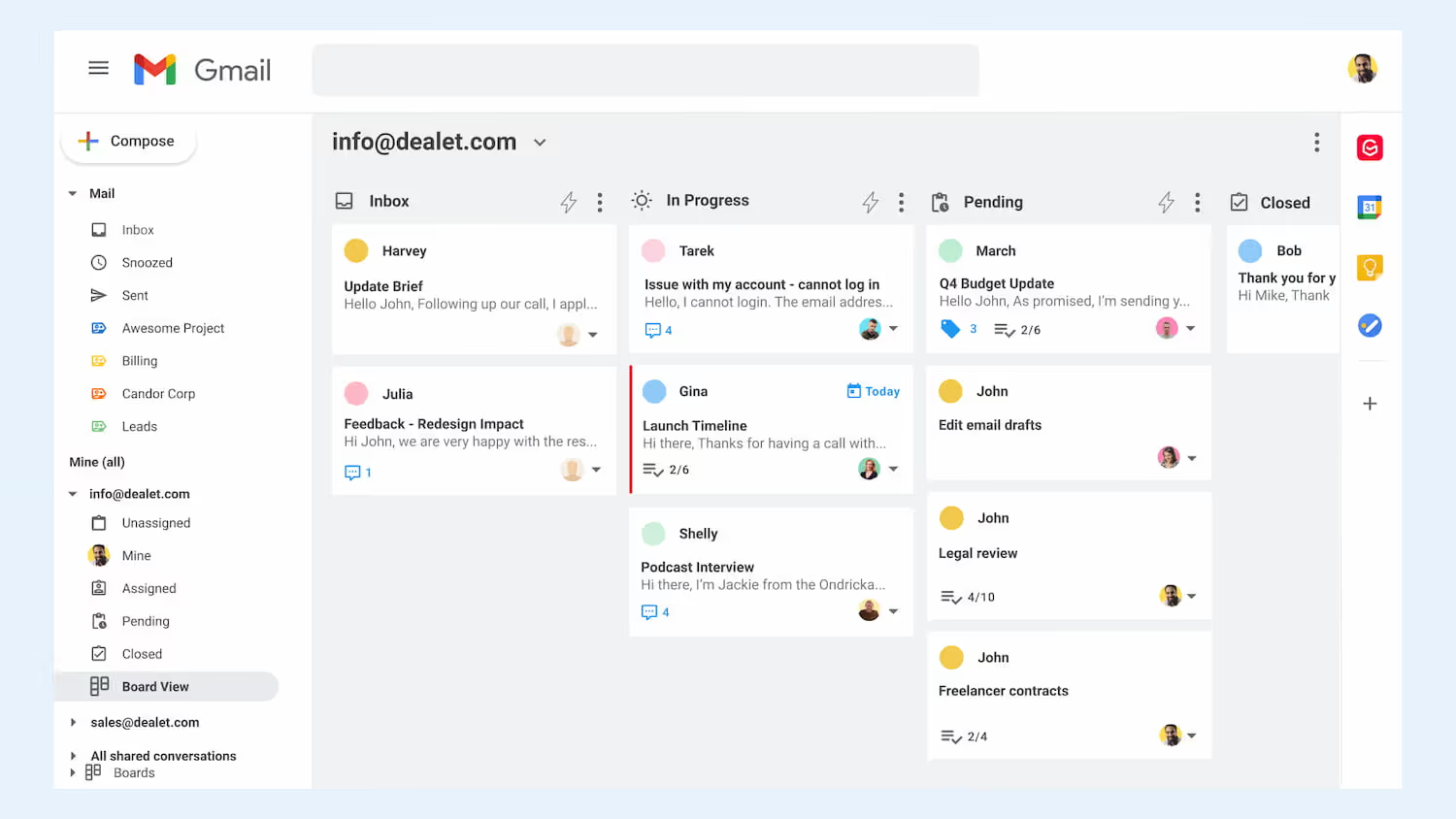
3. Increases transparency across the team
Shared views of conversations, combined with @mentions and notes, mean everyone has access to the same context. Whether someone is on vacation or in another time zone, updates are available instantly.
4. Boosts accountability and follow-through
Assigning emails as tasks prevents important requests from slipping through the cracks. Clear ownership means deadlines are met more consistently.
5. Enhances morale through reduced overload
An organized inbox reduces stress. When people can quickly prioritize and process messages, they feel more in control, and therefore, more motivated to tackle their work.
By combining these benefits, smarter email management becomes more than an organizational tactic. Without being hyperbolic, it brings a genuine cultural shift. Teams communicate more clearly, handle workload with confidence, and keep projects moving forward without unnecessary delays.
Now that we’ve explained email management in detail, let us tackle a fundamental question: So, what exactly is email management software?
It's a tool that helps your team organize, sort, and collaboratively respond to a high volume of emails.
And if your team uses Gmail, then Gmelius is a natural fit.
Gmelius is a collaboration platform designed for Gmail that helps team members streamline email processes, improve communication, and effectively distribute their workloads.
When you're looking for an email management solution, Gmelius offers a wide range of features to supercharge your team's strategy for tackling a crowded inbox. But don’t just take our word for it; in the next section we compare and contrast some of the best solutions out there, and how they measure up against each other.
10 Best Email Management Solutions Compared Side by Side
With so many inbox tools available today, from AI-powered assistants to Kanban-style shared inboxes, selecting the right email management tool can feel overwhelming.
Here’s a head-to-head comparison of ten top contenders so you can match features to your unique workflow.
The table shows how each one of the best email management solutions brings unique strengths, whether it’s boosting transparency with shared Kanban boards, automating triage with smart filters, or accelerating replies via AI drafting.
But it’s not one-size-fits-all: the ideal choice depends on your team’s existing workflow, preferred tools, and daily email challenges.
The bottom line is this: evaluate tools based on how well they fit your own rhythm (not comparison charts alone) because the most powerful email solution is the one that's most customizable to you.
Now, we’ll discuss how to make your choice; what defines and determines your section, and what guarantees you’re on the right track.
How to Select the Best Email Management Software
Choosing the right email management tool isn't about ticking boxes. You need to align the decision with your team’s structure, objectives, stack, and preferred workflows. With clear criteria in hand, the decision becomes strategic, not stressful.
Here’s a structured approach to guide your selection decision effectively:
- Understand your team’s scale & structure: Small startups need light, flexible tools; enterprise support teams require advanced permissions, scalable roles, and robust visibility settings. Select a platform that grows with you.
- Assess email volume & complexity: High traffic? Look for features like automation rules, response templates, and filters to reduce manual handling. For lighter inboxes, simplicity and usability may be your priority.
- Check compatibility with your ecosystem (integrations): A powerful tool is one that plays well with Slack, Trello, CRMs, calendars, and more. Integration reduces friction and keeps workflows smooth.
- Prioritize security & compliance: For teams in regulated industries, prioritize solutions with encryption, audit logs, role-based access, and certifications like GDPR, HIPAA, or SOC 2.
- Look for shared inbox essentials: Shared workflows work best when inboxes have collision detection, internal commenting, and visibility into who’s handling each email.
- Feature flexibility: Templates, Workflows, Automation: Features like assignable emails, rule-based actions, and reusable templates save time while enforcing consistency across the team.
- Ease of use & adoption curve: A tool isn’t useful if your team can’t use it. Prioritize intuitive UI/UX, onboarding options, and responsive support to help your team land smoothly.
- Analytics & reporting capabilities: Choose tools that offer insight into metrics like response times, volume trends, and workload distribution so you can continually refine and improve performance.
Here’s a tick-off checklist so you can systematically evaluate each option and make a confident, data-driven choice:

In the end, no single platform fits every team, and that’s okay. What matters is selecting an email solution that matches your people, workflow, stack, and long-term vision.
And, while we're at it, let’s zero in on a critical email must-have, that you simply cannot ignore, and needs a bit of concentrated and targeted management: customer service emails and how they need specialized and nuanced treatment.
The Best Email Management Software Features for Customer Service
Customer service often hinges on one thing: responsiveness. Not only is a sluggish or cluttered inbox inconvenient, but it can also damage your brand's credibility and cost real customers. The right email management software turns your Gmail into a more-than-workable helpdesk.
It allows you to:
Spot and fix inbox chaos early
Common obstacles like disorganized mail, duplicate replies, or missing messages can silently erode customer trust, plus your bottom line. Identifying these gaps is the first step toward transformation.
Assign clear ownership for every message
Mistakes happen when no one owns an email. Delegating tasks directly from Gmail ensures accountability, faster resolution, and fewer dropped conversations.
Automate replies and workflows with precision
Use rule-based automation to instantly respond and route emails—e.g., auto-reply incoming “support” emails and label them correctly. This precision saves time and upholds SLAs.
Drive clarity with visual task boards
Convert emails into Kanban-style tickets right in your inbox. Custom columns, like “To Do,” “In Progress,” and “Closed,” offer real-time visibility into workload and progress.
Stay ahead with analytics insights
Track metrics (response time, volume trends, team load) to optimize operations, avoid burnout, and improve customer satisfaction continuously.
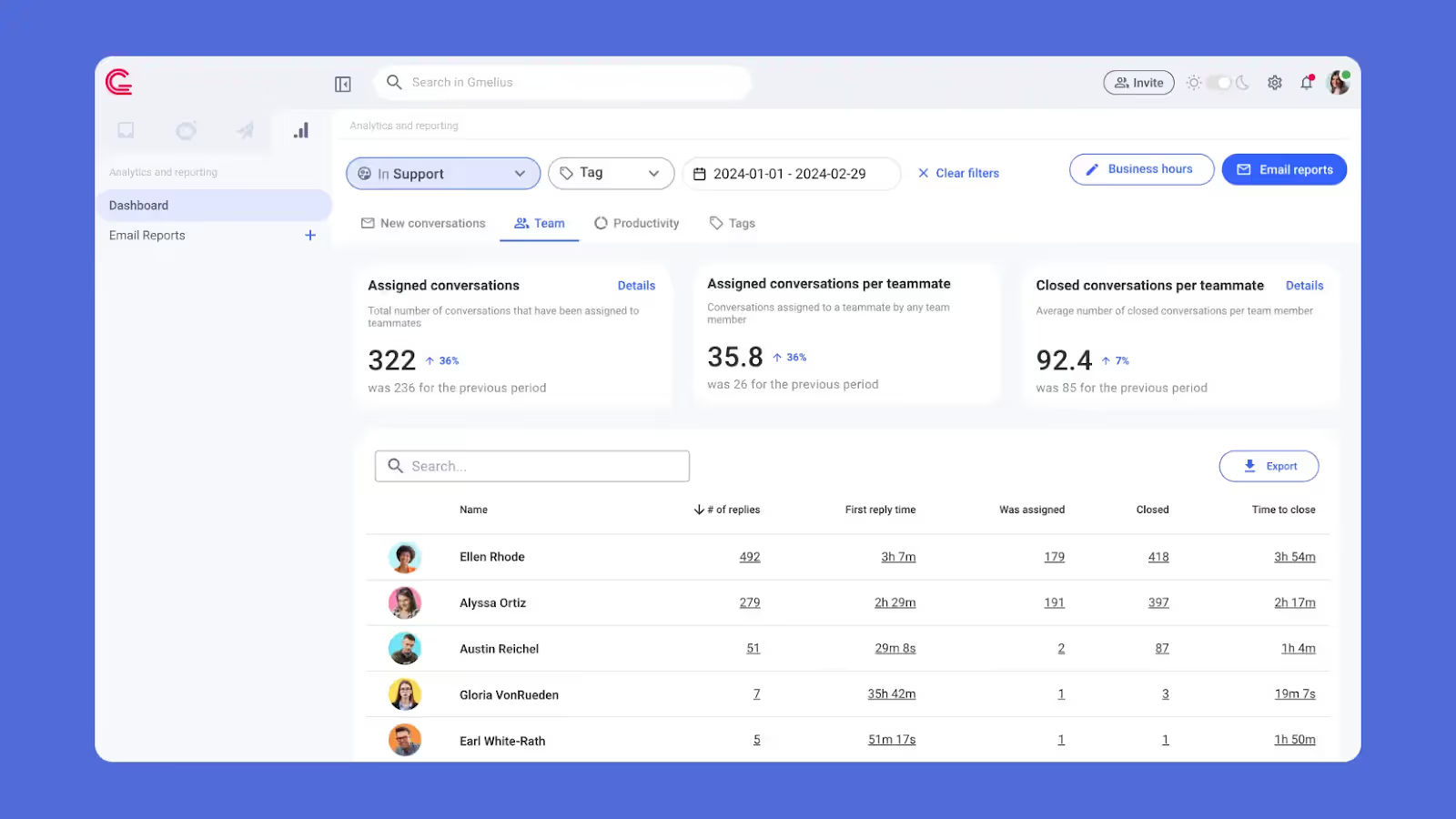
These email management features for customer service do more than enhance responsiveness. You can rebuild customer support as a unified, accountable, and data-driven team workflow.
Shared Inbox, Shared Gmail Labels, Automation, and More with Gmelius
Implementing a robust email management solution like Gmelius for your team makes email management worries a thing of the past. Gmelius allows your teams to manage group emails like support@ or info@ much faster by using a shared inbox.
A shared inbox gives every team member the power to manage any company email you choose, right from Gmail.
- Eliminate clutter by managing company emails together as a team
- Delegate assignments to specific team members with ease
- Run internal conversations right alongside an email
- Turn emails into actionable tickets with Gmail Kanban boards
- Draft replies automatically with AI reply assistants
How does this work?
Once you install Gmelius, your familiar Gmail inbox transforms into your powerful new workspace (but without too much of a learning curve!).
Our email management tool seamlessly integrates into a platform you already know and use every day. Gmelius becomes the home not only for a shared inbox for your team but also for shared Gmail labels and a host of other fantastic features for team collaboration and workflow automation.
Without being hyperbolic, shared Gmail labels can truly revolutionize email management. For example, that "important" folder you keep dumping more emails into? You no longer have to conquer that mountain alone.
Your team can share new or existing Gmail labels and synchronize conversations in real-time across all team members.
What’s more, Gmelius allows Gmail to integrate with other popular communication platforms like Slack or Trello. This is thanks to our 2-way integration architecture, which lets your team connect their everyday tools.
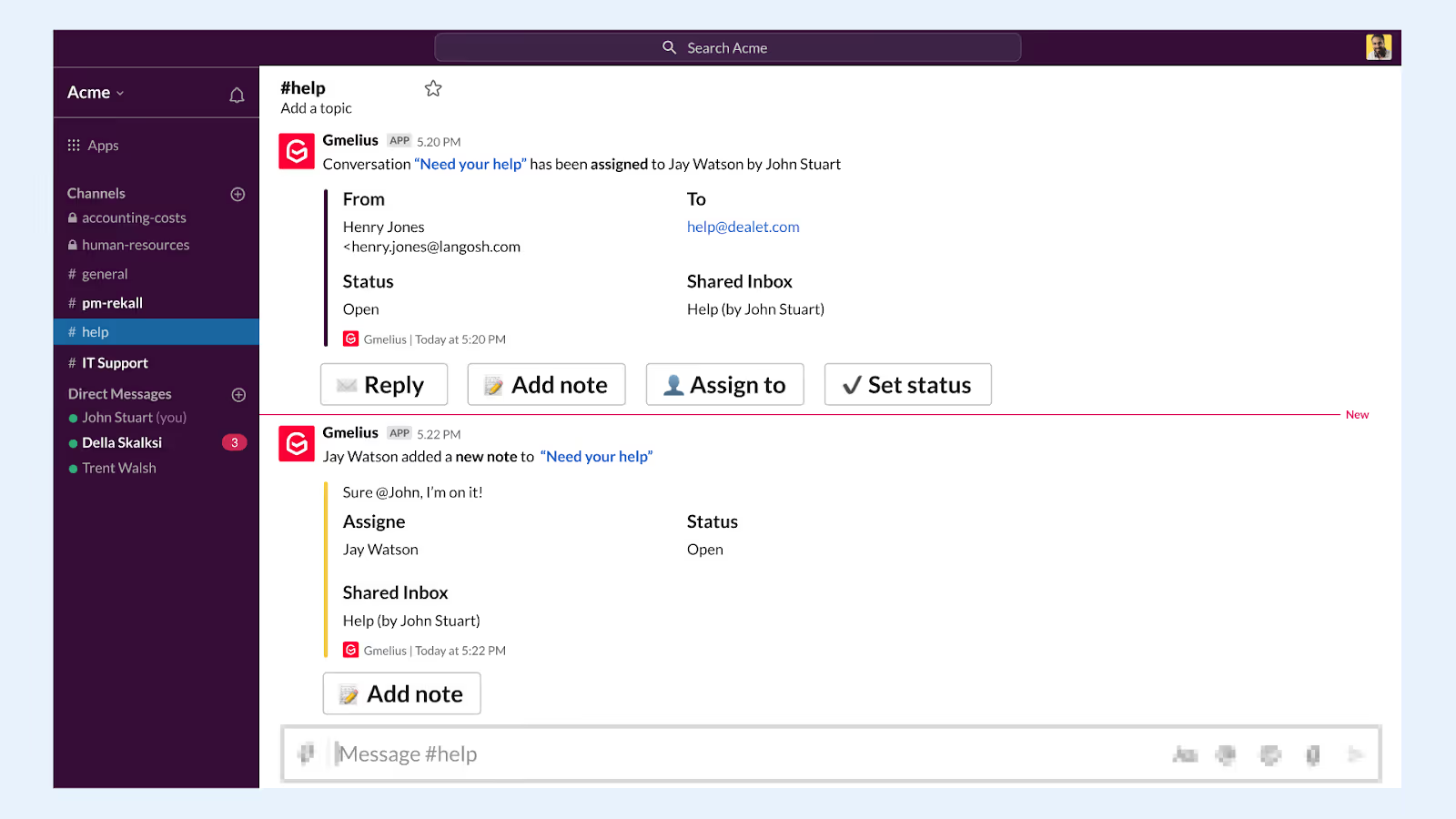
Plus, you can convert any conversation into a task card and manage inboxes and projects with Gmail Kanban boards—a visual project management tool. This feature helps team members easily see what needs to be done, what tasks are in progress, and what’s pending.
Since a lot of time can be wasted switching between multiple email accounts and constantly CC'ing colleagues, your team can finally ditch those never-ending email threads and focus more on collaborating within one unified platform. Gmelius can further simplify this problem by using automation. Automating emails ensures the right team members focus on the emails that are truly relevant to them.
Workflow distribution is key to getting emails assigned to the correct person, which helps increase response times and provides crucial context for tasks that need to go to a specific team member.
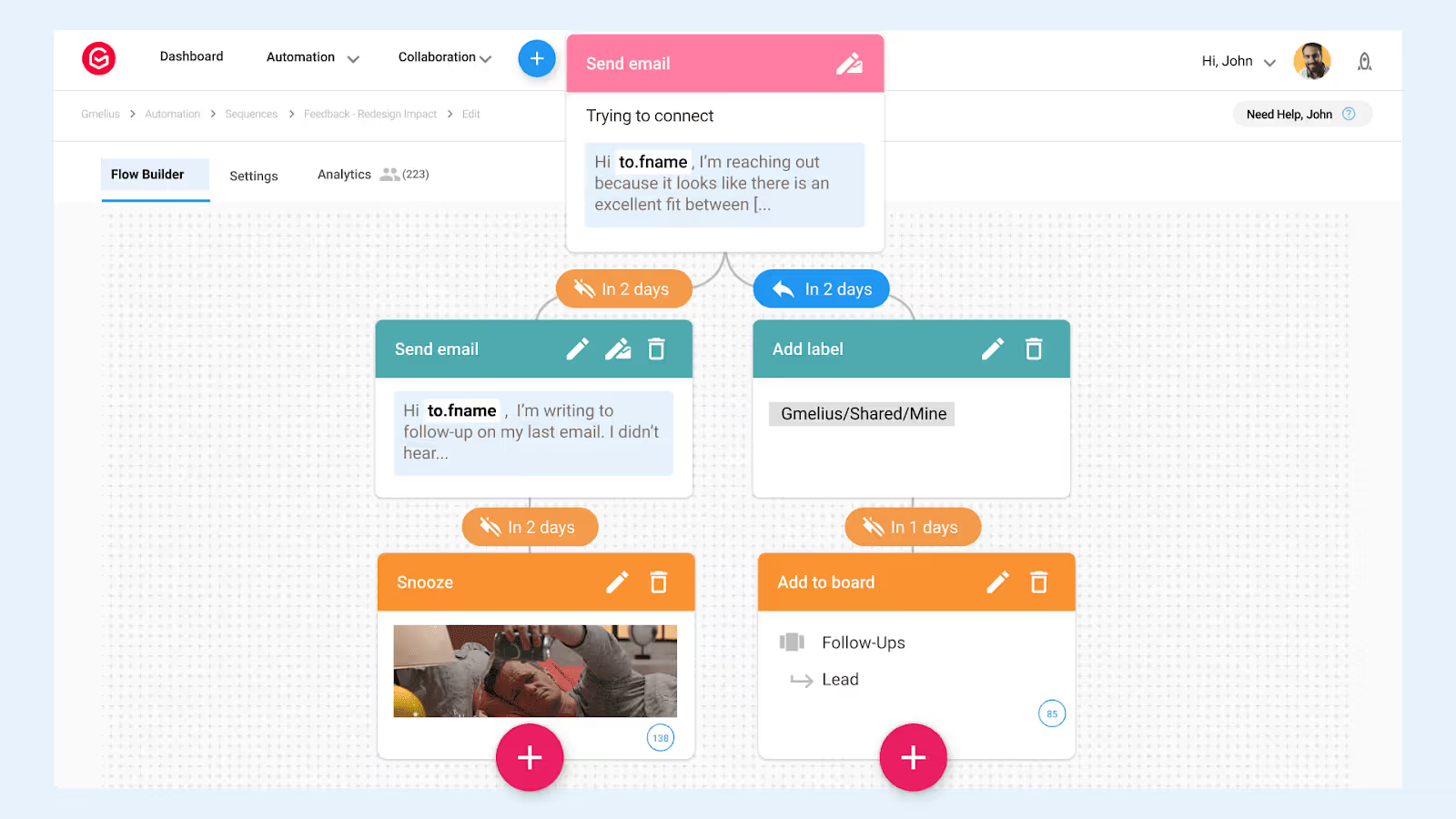
Additionally, our software can recognize specific keywords in an email—for example, "return" or "invoice"—so emails can be delegated properly to the right team member, automating your company's daily processes and boosting workflow.
Your team can choose triggers and set conditions to auto-assign emails, apply tags, and add notes for extra context. We explain further in our guide to addressing team email management challenges.
Finally, before we leave you we need to discuss the elephant in the room: AI, and its genuinely game-changing capabilities when it comes to email management. It’s a handy “li’l partner” and factotum that can improve how you work and how your email behaves.
Harnessing AI for Email Management
AI-powered tools can step in as your virtual assistants, quietly managing clutter while you stay focused on what matters most. Here’s how AI can help manage emails in a very realistic way:
1. Automate email sorting and prioritization
AI can instantly categorize and prioritize messages, tagging urgent ones, shelving routine updates, and delivering your inbox with clarity. This keeps overlooked messages to a minimum and urgency front-of-mind.
2. Draft smarter, not harder
With context-aware drafting, AI tools like Gmelius can generate reply suggestions that align with your tone and thread, no prompt required. You just tweak and send.
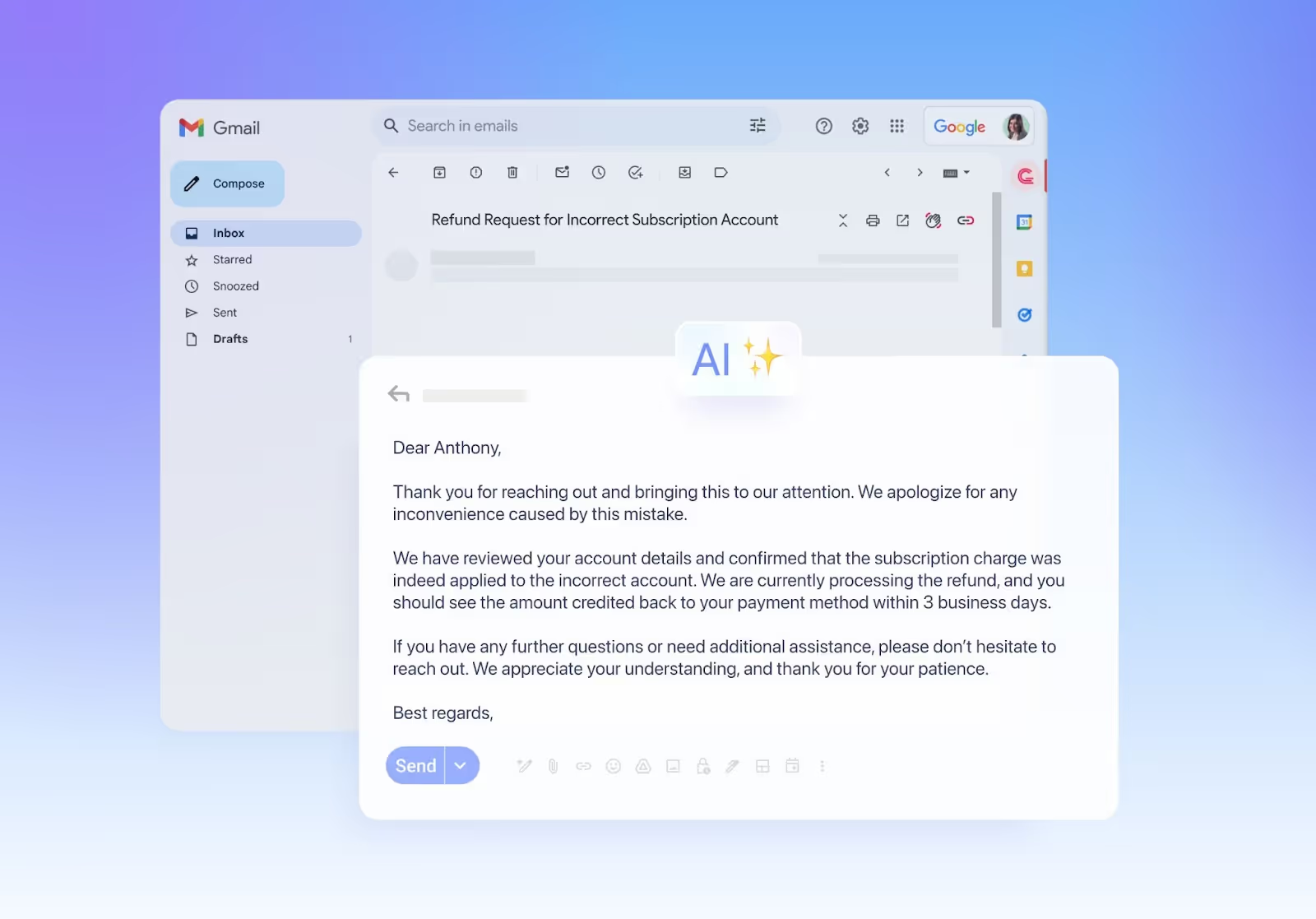
3. Minimize errors when you’re replying to email
AI acts as a second set of eyes, spotting typos, detecting mismatched addresses, and flagging missing attachments before you hit send. It allows users to save time and avoid costly errors.
4. Unlock smarter workflows
Automate tag suggestions, automate response triggers, and let AI adapt over time. It becomes more intuitive the more you lean on it, blending into your workflow like a silent helper.
5. Gain actionable insights
Beyond automation, AI features can eventually provide analytics showing which threads linger, where bottlenecks occur, and how your inbox usage patterns evolve.
Stop Postponing Email Management – Try Gmelius
Email management software literally gives your team valuable time back in their day. When all team members manage group emails, it ensures important messages are read, labeled, and addressed promptly.
This management method also significantly improves organization, giving every email a designated place for storage, ensuring important conversations are well-documented and addressed. Plus, you can remove these emails from your main inbox, creating much-needed space.
So, when you wonder: "What is email management?" know that it goes far beyond simply organizing an inbox. Email management software empowers your team with high-quality features that can have a massive impact on your company’s day-to-day workflow, maximizing efficiency, productivity, and improving collaboration for the long haul.
Make work and life easier with AI email management. Get a Gmelius demo today.
Email Management FAQs:
1. How can I reduce the number of emails I receive every day?
Start by unsubscribing from newsletters or alerts you don’t read. Use filters or rules to direct low-priority messages into separate folders. If possible, move certain conversations to shared documents or chat tools to reduce back-and-forth.
2. What’s the best way to organize my inbox?
There’s no one right way—some people prefer folders by project or client, others use labels or tags. A simple system is to have three main areas: “To Do,” “Waiting For,” and “Archive.” The key is consistency, not complexity.
3. How do I keep my inbox from feeling overwhelming?
Try “batching” email checks—limit yourself to specific times of day rather than checking constantly. Archive or delete anything that doesn’t require action. Even small daily maintenance helps prevent buildup.
4. How can I respond to important emails faster?
Mark urgent emails with a flag or star. Keep short template replies ready for common questions, so you can answer quickly without starting from scratch. Use search filters to find high-priority messages first.
5. What’s the difference between archiving and deleting emails?
Archiving removes the email from your inbox but keeps it searchable. Deleting removes it from your account (though you may still find it in “Trash” for a short time). Archive if you might need it later; delete if you’re sure you won’t.
6. How do I manage email when I’m away from work?
Set up an out-of-office reply with your return date and an alternate contact. Consider creating an inbox rule to sort or flag messages you’ll need to review when you’re back.
7. Is it better to sort emails manually or let filters do it?
If your inbox volume is high, filters save time by auto-sorting messages into folders or categories. If your volume is low, manual sorting may be enough. You can also use a mix—filters for predictable senders, manual for everything else.
8. How can I stop missing important messages?
Whitelist important contacts so their emails never go to spam. Use alerts or push notifications for specific senders or subjects. Regularly check your spam/junk folder for false positives.
9. How do I handle email threads that go on too long?
If the topic has drifted or the chain is getting unmanageable, start a new thread with a clear subject line summarizing the next steps. This keeps the conversation focused and easier to search later.
10. How can I search my inbox more effectively?
Learn your email platform’s search operators. For example, you can search by sender, date range, attachment type, or keyword. This saves time and avoids endless scrolling.
11. How can Gmelius help in email management?
Yes. Gmelius helps manage email by letting you organize, assign, and track messages, automate repetitive tasks, and collaborate with your team directly inside Gmail.
12. Can I use Gmelius to automate repetitive email tasks?
Yes. You can set up workflows that automatically label, assign, or send pre-written responses based on certain triggers.



.avif)
.avif)
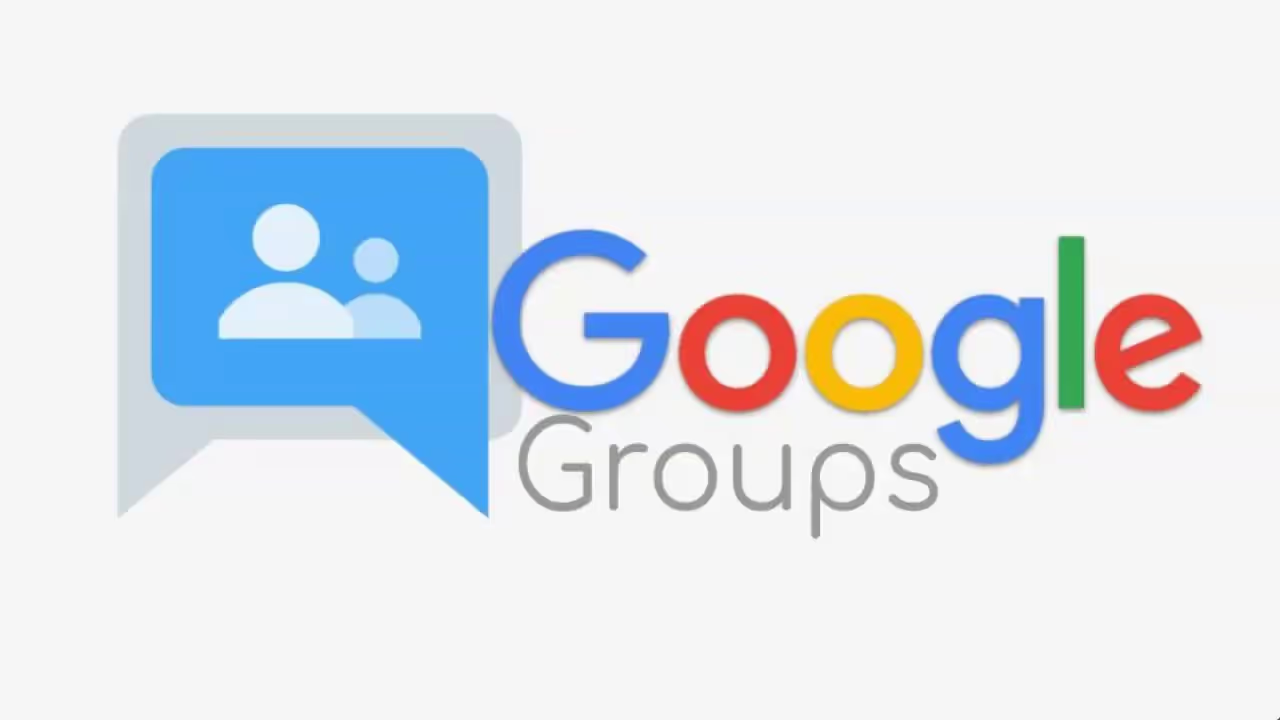
.avif)
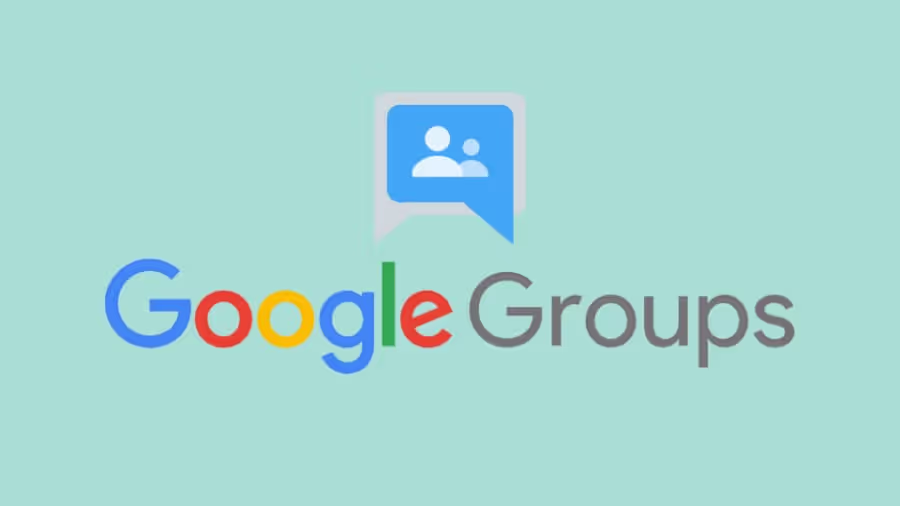
.avif)